Tropical Cyclone Impacts on Headland Protected Bay
Abstract
1. Introduction
2. Methods
2.1. Location
2.2. Tropical Cyclone Oma
3. Data Collection and Analysis
4. Results
4.1. Metocean Conditions
4.2. Beach Response
5. Discussion
6. Conclusions
Supplementary Materials
Author Contributions
Funding
Acknowledgments
Conflicts of Interest
References
- Australia’s Top 10 Beaches. Available online: https://www.experienceoz.com.au/en/top-10-beaches-in-australia (accessed on 3 August 2019).
- Domain House Price Report, March 2019. Available online: https://www.domain.com.au/research/house-price-report/march-2019/ (accessed on 3 August 2019).
- Noosa Shire Council Economic Profile. Available online: https://economy.id.com.au/noosa/employment-by-industry (accessed on 3 August 2019).
- Burvingt, O.; Masselink, G.; Russell, P.; Scott, T. Classification of beach response to extreme storms. Geomorphology 2017, 295, 722–737. [Google Scholar] [CrossRef]
- Vieira da Silva, G.; Toldo, E.E.; Klein, A.H.d.F.; Short, A.D.; Woodroffe, C.D. Headland sand bypassing—Quantification of net sediment transport in embayed beaches, Santa Catarina Island North Shore, Southern Brazil. Mar. Geol. 2016, 379, 13–27. [Google Scholar] [CrossRef]
- Short, A.D. Three dimensional beach stage model. J. Geol. 1979, 87, 553–571. [Google Scholar] [CrossRef]
- Short, A.D. Handbook of Beach and Shoreface Morphodynamics; John Wiley: Chichester, UK, 1999. [Google Scholar]
- Oliveira, S.; Moura, D.; Horta, J.; Nascimento, A.; Gomes, A.; Veiga-Pires, C. The morphosedimentary behaviour of a headland–beach system: Quantifying sediment transport using fluorescent tracers. Mar. Geol. 2017, 388, 62–73. [Google Scholar] [CrossRef]
- Vieira da Silva, G.; Toldo Jr, E.E.; Klein, A.H.d.F.; Short, A.D. The influence of wave-, wind- and tide-forced currents on headland sand bypassing—Study case: Santa Catarina Island north shore, Brazil. Geomorphology 2018, 312, 1–11. [Google Scholar] [CrossRef]
- Fellowes, T.E.; Vila-Concejo, A.; Gallop, S.L. Morphometric classification of swell-dominated embayed beaches. Mar. Geol. 2019, 411, 78–87. [Google Scholar] [CrossRef]
- Goodwin, I.D.; Freeman, R.; Blackmore, K. An insight into headland sand bypassing and wave climate variability from shoreface bathymetric change at Byron Bay, New South Wales, Australia. Mar. Geol. 2013, 341, 29–45. [Google Scholar] [CrossRef]
- CSIRO and Bureau of Meteorology. Climate Change in Australia Information for Australia’s Natural Resource Management Regions; Technical Report; CSIRO and Bureau of Meteorology: Canberra, Australia, 2015.
- Kopp, R.E.; DeConto, R.M.; Bader, D.A.; Hay, C.C.; Horton, R.M.; Kulp, S.; Oppenheimer, M.; Pollard, D.; Strauss, B.H. Evolving Understanding of Antarctic Ice-Sheet Physics and Ambiguity in Probabilistic Sea-Level Projections. Earth’s Future 2017, 5, 1217–1233. [Google Scholar] [CrossRef]
- The Noosa Plan-Coastal Hazards Mapping. Available online: https://www.noosa.qld.gov.au/planning-development/the-noosa-plan/coastal-hazards-mapping (accessed on 24 March 2020).
- Mortlock, T.R.; Goodwin, I.D. Directional wave climate and power variability along the Southeast Australian shelf. Cont. Shelf Res. 2015, 98, 36–53. [Google Scholar] [CrossRef]
- Kossin, J.P.; Emanuel, K.A.; Vecchi, G.A. The poleward migration of the location of tropical cyclone maximum intensity. Nature 2014, 509, 349–352. [Google Scholar] [CrossRef]
- Lavender, S.L.; Walsh, K.J.E. Dynamically downscaled simulations of Australian region tropical cyclones in current and future climates. Geophys. Res. Lett. 2011, 38. [Google Scholar] [CrossRef]
- McCarroll, R.; Masselink, G.; Valiente, N.; Scott, T.; King, E.; Conley, D. Wave and Tidal Controls on Embayment Circulation and Headland Bypassing for an Exposed, Macrotidal Site. J. Mar. Sci. Eng. 2018, 6. [Google Scholar] [CrossRef]
- McCarroll, R.J.; Brander, R.W.; Turner, I.L.; Power, H.E.; Mortlock, T.R. Lagrangian observations of circulation on an embayed beach with headland rip currents. Mar. Geol. 2014, 355, 173–188. [Google Scholar] [CrossRef]
- Phillips, M.S.; Blenkinsopp, C.E.; Splinter, K.D.; Harley, M.D.; Turner, I.L. Modes of Berm and Beachface Recovery Following Storm Reset: Observations Using Continuously Scanning Lidar. J. Geophys. Res. Earth Surf. 2019, 124, 720–736. [Google Scholar] [CrossRef]
- Voisey, C.J.; Teakle, I.; Andrews, M. Mooloolaba entrance siltation indicator tool 8 years on. In Proceedings of the Coasts and Ports 2013: 21st Australasian Coastal and Ocean Engineering Conference and the 14th Australasian Port and Harbour Conference, Sydney, Australia, 11–13 September 2013; pp. 821–826. [Google Scholar]
- Nichol, S.L.; McPherson, A.; Davies, G.; Jiang, W.; Howard, F.; Gravois, U.; Callaghan, D.; Baldock, T. A Framework for Modelling Shoreline Response to Clustered Storm Events: A Case Study from Southeast Australia. J. Coast. Res. 2016, 75, 1197–1201. [Google Scholar] [CrossRef]
- George, D.A.; Largier, J.L.; Storlazzi, C.D.; Barnard, P.L. Classification of rocky headlands in California with relevance to littoral cell boundary delineation. Mar. Geol. 2015, 369, 137–152. [Google Scholar] [CrossRef]
- Barnes, M.; Huxley, C.; Andrews, M. Sunshine Coast Regional Council—Coastal Processes Study for the Sunshine Coast; BMT WBM: Brisbane, Australia, 2013. [Google Scholar]
- Cato, N. The Noosa Story: A Study in Unplanned Development, 3rd ed.; Jacaranda Press: Milton, QLD, Australia, 1989. [Google Scholar]
- The Australian Tropical Cyclone Database. Available online: http://www.bom.gov.au/cyclone/history/ (accessed on 14 April 2019).
- Victory, S.J. Beach Protection Authority; Main Beach Technical Report; Beach prtoection authority of Queensland: Brisbane, Australia, 1998. [Google Scholar]
- Severe Tropical Cyclone Oma. Available online: http://www.bom.gov.au/announcements/sevwx/qld/qldtc20190212.shtml (accessed on 3 May 2019).
- Wave Monitoring Sites. Available online: https://www.qld.gov.au/environment/coasts-waterways/beach/monitoring/waves-sites (accessed on 14 April 2019).
- SWAN Scietific and Technical Documentation, Version 41.10. Available online: http://swanmodel.sourceforge.net/online_doc/swantech/swantech.html (accessed on 5 November 2018).
- Queensland Government. Queensland Coastal Risk and Bathymetric LiDAR: A Pilot Study for Collecting Near-Shore Bathymetry; Queensland Department of Science, Information Technology, Innovation and the Arts: Brisbane, Australia, 2012. [Google Scholar]
- High-Resolution Depth Model for the Great Barrier Reef–30m. Available online: https://researchdata.ands.org.au/high-resolution-depth-30-m/1278835?source=suggested_datasets (accessed on 4 February 2019).
- Saha, S.; Moorthi, S.; Wu, X.; Wang, J.; Nadiga, S.; Tripp, P.; Behringer, D.; Hou, Y.; Chuang, H.; Iredell, M. The NCEP Climate Forecast System Version 2. J. Clim. 2014, 27, 2185–2208. [Google Scholar] [CrossRef]
- Saha, S.N.; Thiaw, C.; Wang, J.; Wang, W.; Zhang, Q.; Van Den Dool, H.M.; Pan, H.-L.; Moorthi, S.; Behringer, D.; Stokes, D. The NCEP Climate Forecast System. J. Clim. 2006, 19. [Google Scholar] [CrossRef]
- Tide Monitoring Sites. Available online: https://www.qld.gov.au/environment/coasts-waterways/beach/tide-sites (accessed on 27 March 2019).
- Lee, J.-M.; Park, J.-Y.; Choi, J.-Y. Evaluation of Sub-aerial Topographic Surveying Techniques Using Total Station and RTK-GPS for Applications in Macrotidal Sand Beach Environment. J. Coast. Res. 2013, 65, 535–540. [Google Scholar] [CrossRef]
- Morton, R.A. Monitoring Beach Changes Using GPS Surveying Techniques. J. Coast. Res. 1993, 9, 702–720. [Google Scholar]
- Taddia, Y.; Stecchi, F.; Pellegrinelli, A. Using Dji Phantom 4 Rtk Drone for Topographic Mapping of Coastal Areas. In ISPRS—International Archives of the Photogrammetry, Remote Sensing and Spatial Information Sciences 2019; International Society of Photogrammetry and Remote Sensing: Enschede, The Netherlands, 2019; pp. 625–630. [Google Scholar]
- Turner, I.L.; Harley, M.D.; Drummond, C.D. UAVs for coastal surveying. Coast. Eng. 2016, 114, 19–24. [Google Scholar] [CrossRef]
- Phantom 4 RTK Specs. Available online: https://www.dji.com/au/phantom-4-rtk/info#specs (accessed on 3 February 2020).
- Sibson, R. A Brief Description of Natural Neighbor Interpolation. In Interpolating Multivariate Data; Barnett, V., Ed.; John Wiley & Sons: New York, NY, USA, 1981; pp. 21–36. [Google Scholar]
- James, M.R.; Robson, S. Mitigating systematic error in topographic models derived from UAV and ground-based image networks. Earth Surf. Process. Landf. 2014, 39, 1413–1420. [Google Scholar] [CrossRef]
- Chai, T.; Draxler, R.R. Root mean square error (RMSE) or mean absolute error (MAE)?—Arguments against avoiding RMSE in the literature. Geosci. Model Dev. 2014, 7, 1247–1250. [Google Scholar] [CrossRef]
- Le Mauff, B.; Juigner, M.; Ba, A.; Robin, M.; Launeau, P.; Fattal, P. Coastal monitoring solutions of the geomorphological response of beach-dune systems using multi-temporal LiDAR datasets (Vendée coast, France). Geomorphology 2018, 304, 121–140. [Google Scholar] [CrossRef]
- James, M.R.; Robson, S.; Smith, M.W. 3-D uncertainty-based topographic change detection with structure-from-motion photogrammetry: Precision maps for ground control and directly georeferenced surveys. Earth Surf. Process. Landf. 2017, 42, 1769–1788. [Google Scholar] [CrossRef]
- Harley, M.D.; Kinsela, M.A.; Sánchez-García, E.; Vos, K. Shoreline change mapping using crowd-sourced smartphone images. Coast. Eng. 2019, 150, 175–189. [Google Scholar] [CrossRef]
- Mortlock, T.R.; Goodwin, I.D.; Turner, I.L. Nearshore SWAN model sensitivities to measured and modelled offshore wave scenarios at an embayed beach compartment, NSW, Australia. Aust. J. Civ. Eng. 2014, 12. [Google Scholar] [CrossRef]
- Splinter, K.D.; Carley, J.T.; Golshani, A.; Tomlinson, R. A relationship to describe the cumulative impact of storm clusters on beach erosion. Coast. Eng. 2014, 83, 49–55. [Google Scholar] [CrossRef]
- Beuzen, T.; Turner, I.L.; Blenkinsopp, C.E.; Atkinson, A.; Flocard, F.; Baldock, T.E. Physical model study of beach profile evolution by sea level rise in the presence of seawalls. Coast. Eng. 2018, 136, 172–182. [Google Scholar] [CrossRef]
- Kraus, N.C.; McDougal, W.G. The Effects of Seawalls on the Beach-Part I. an updated literature review. J. Coast. Res. 1996, 12, 691–701. [Google Scholar]
- Saunders, M.; Runting, R.; Charles-Edwards, E.; Syktus, J.; Leon, J.X. Projected changes to population, climate, sea-level and ecosystems. In Moreton Bay Quandamooka & Catchment: Past, Present, and Future; Tibbetts, I.R., Rothlisberg, P.C., Neil, D.T., Homburg, T.A., Brewer, D.T., Arthington, A.H., Eds.; The Moreton Bay Foundation: Brisbane, Australia, 2019; pp. 245–255. [Google Scholar]
- Australian Atomic Energy Commission. A Radioactive Tracer Study of the Movement of Nearshore Sand Near Noosa Beach; Australian Atomic Energy Commission: Canberra, Australia, 1981. [Google Scholar]
- Castelle, B.; Scott, T.; Brander, R.W.; McCarroll, R.J. Rip current types, circulation and hazard. Earth-Sci. Rev. 2016, 163, 1–21. [Google Scholar] [CrossRef]
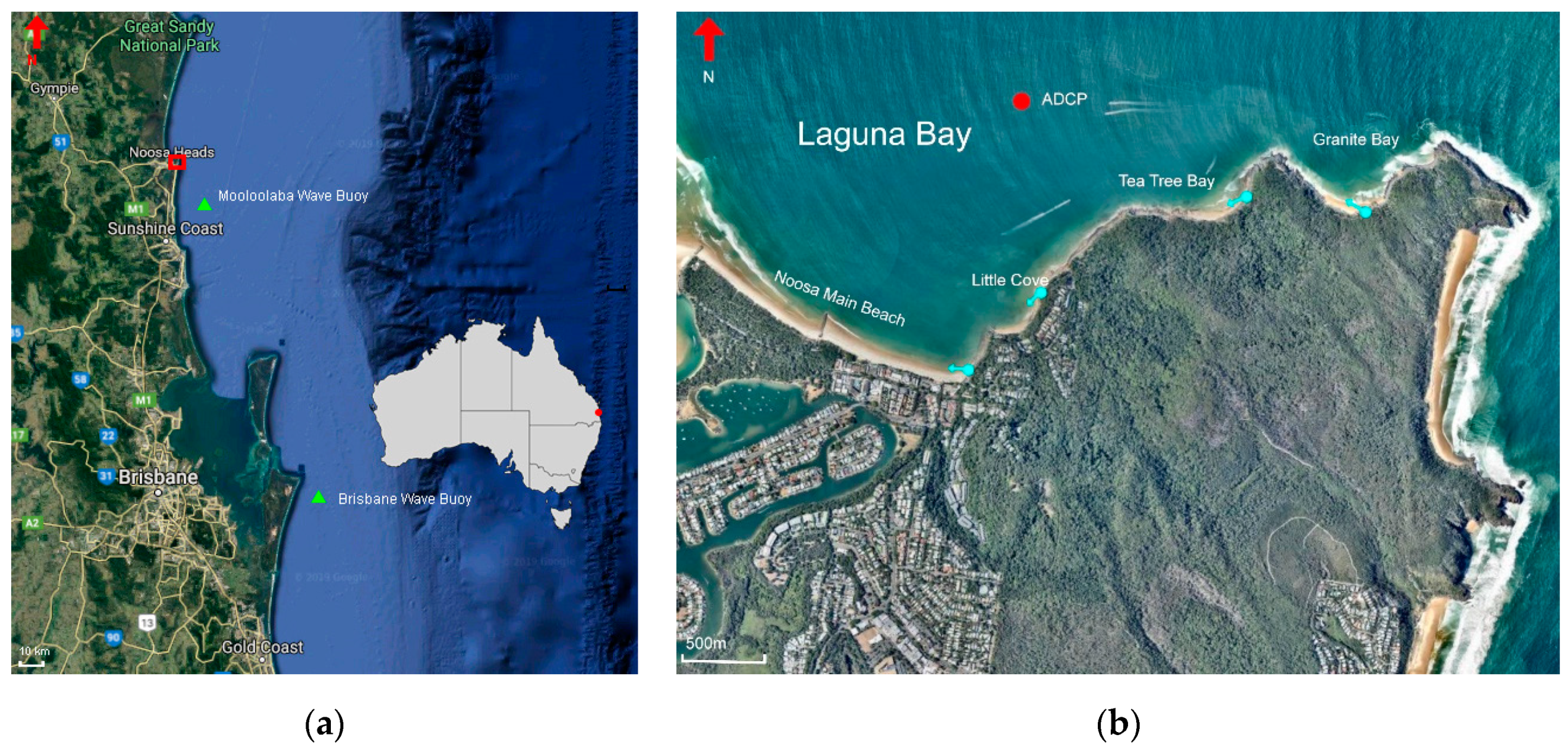
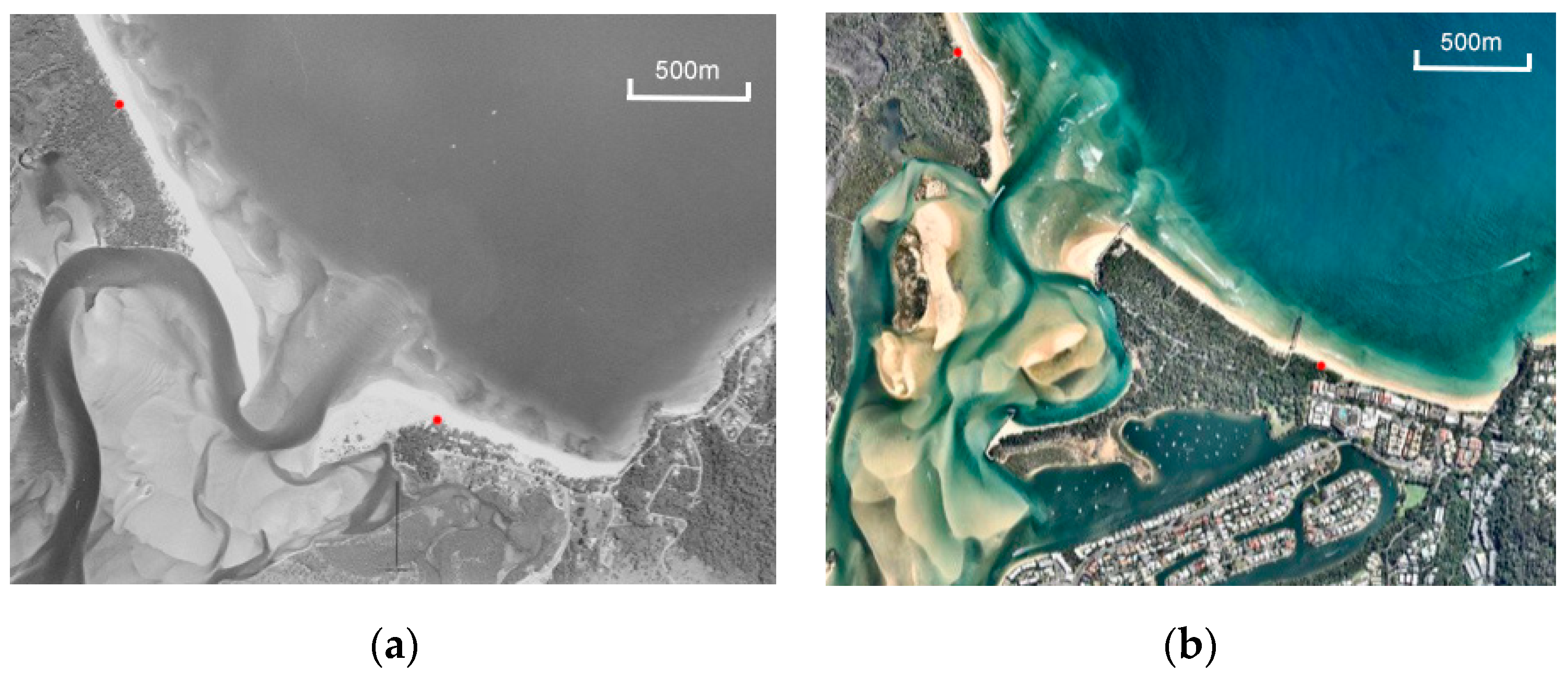
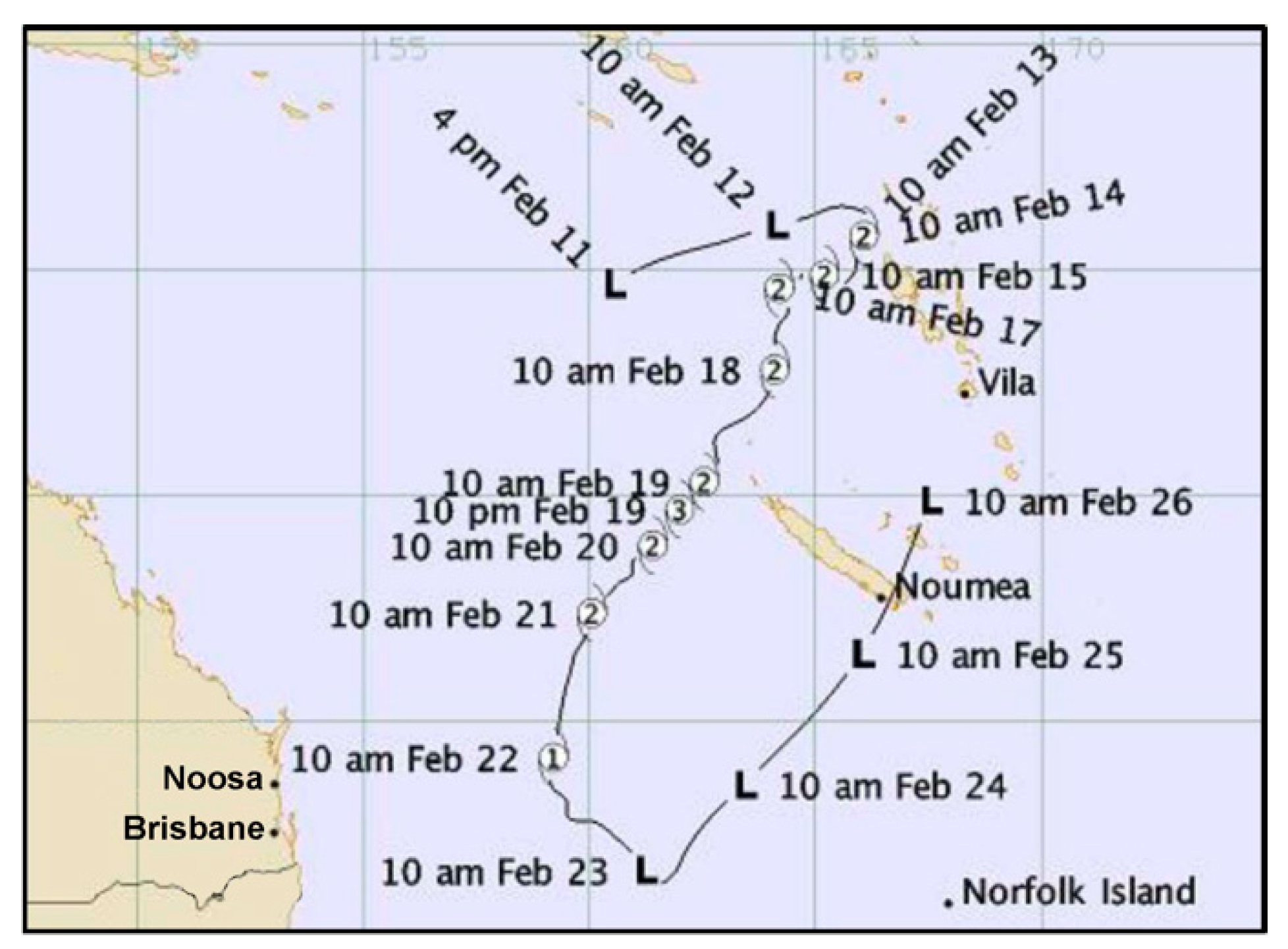
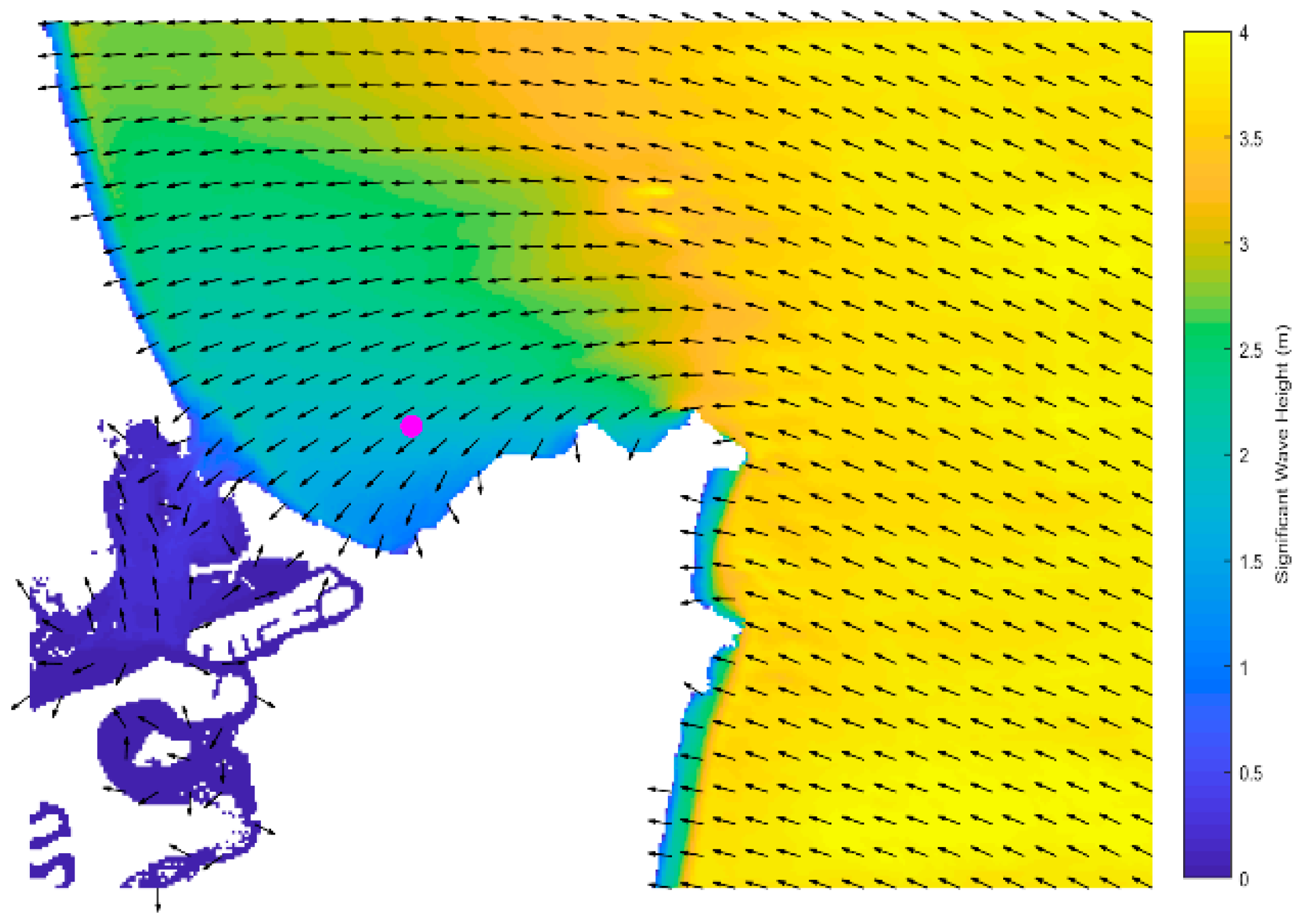
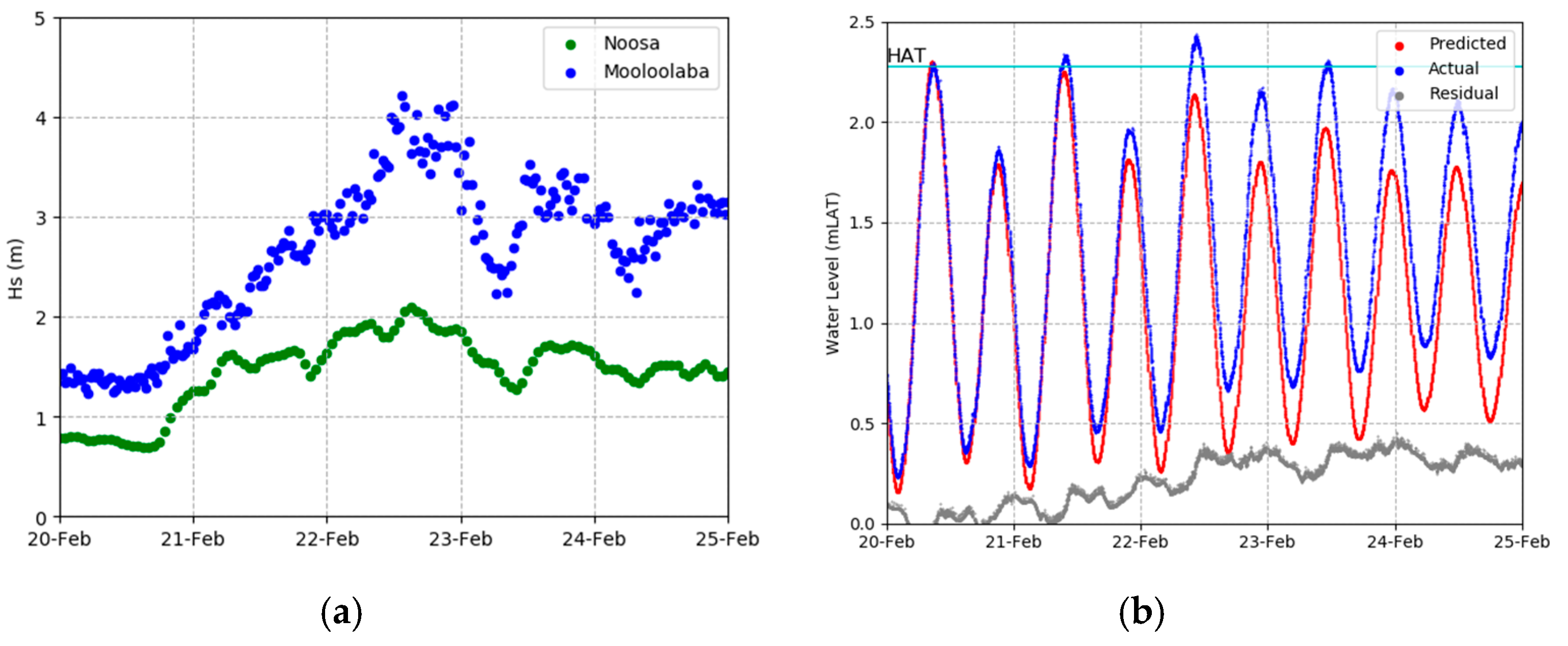
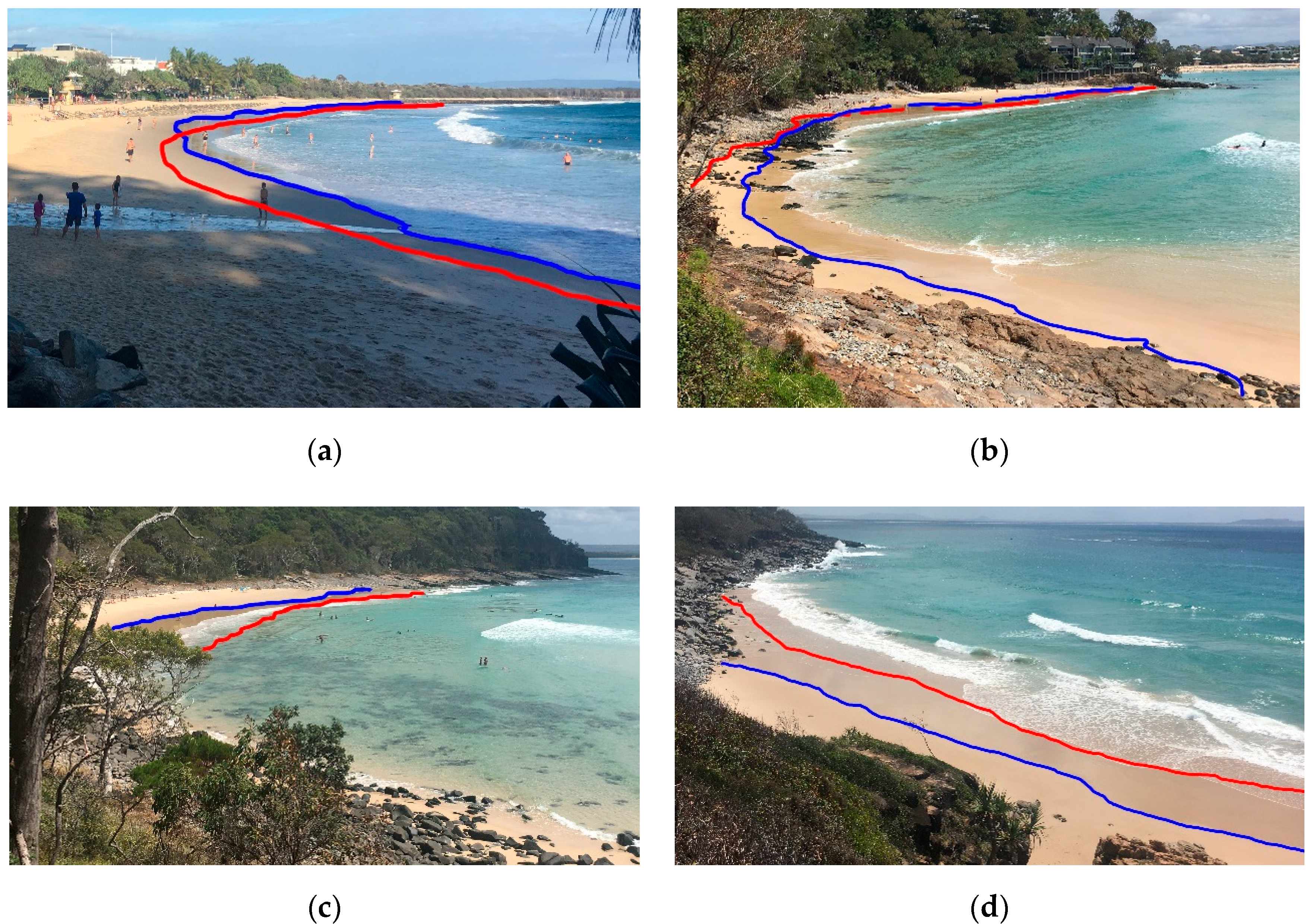
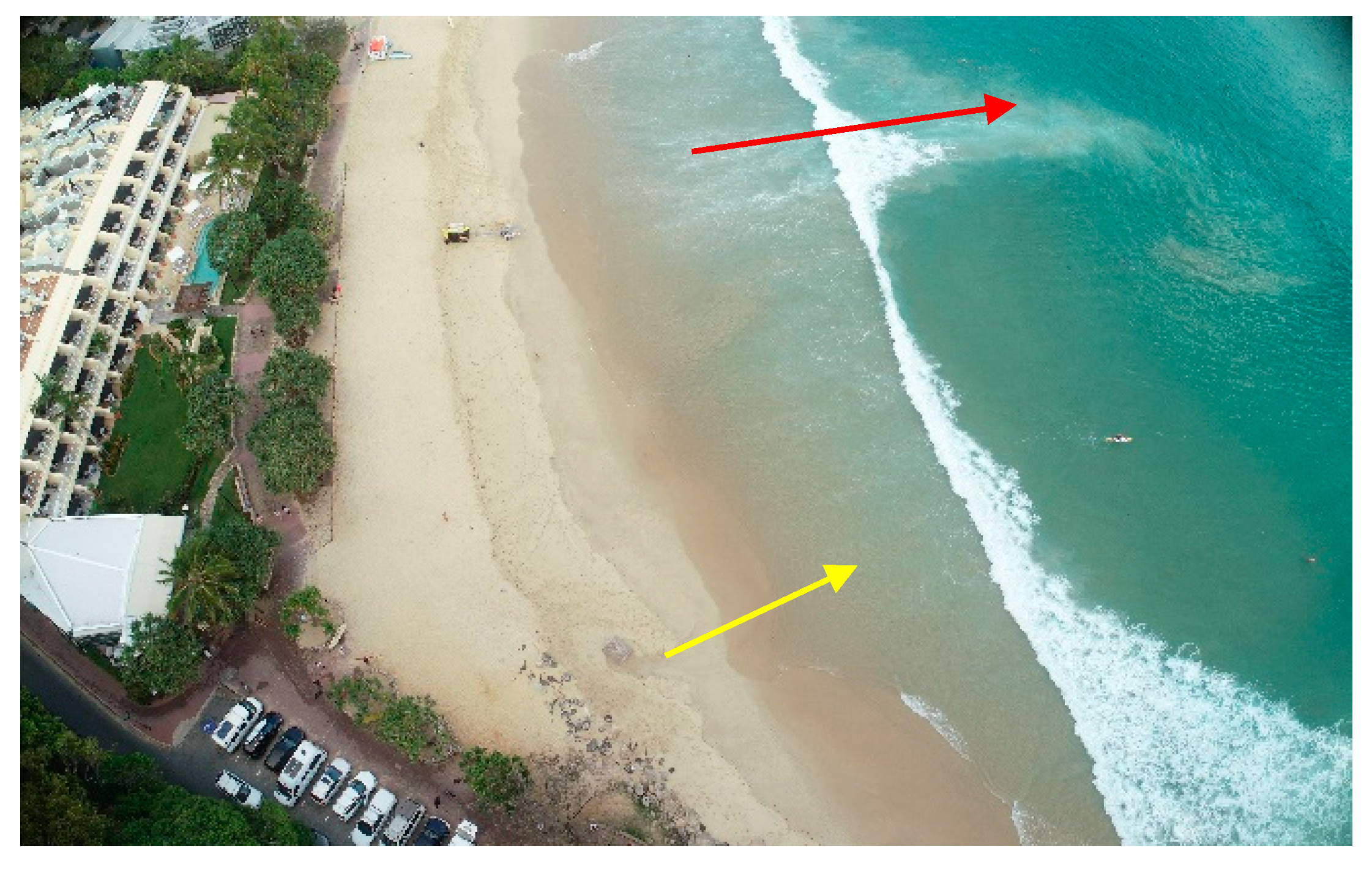
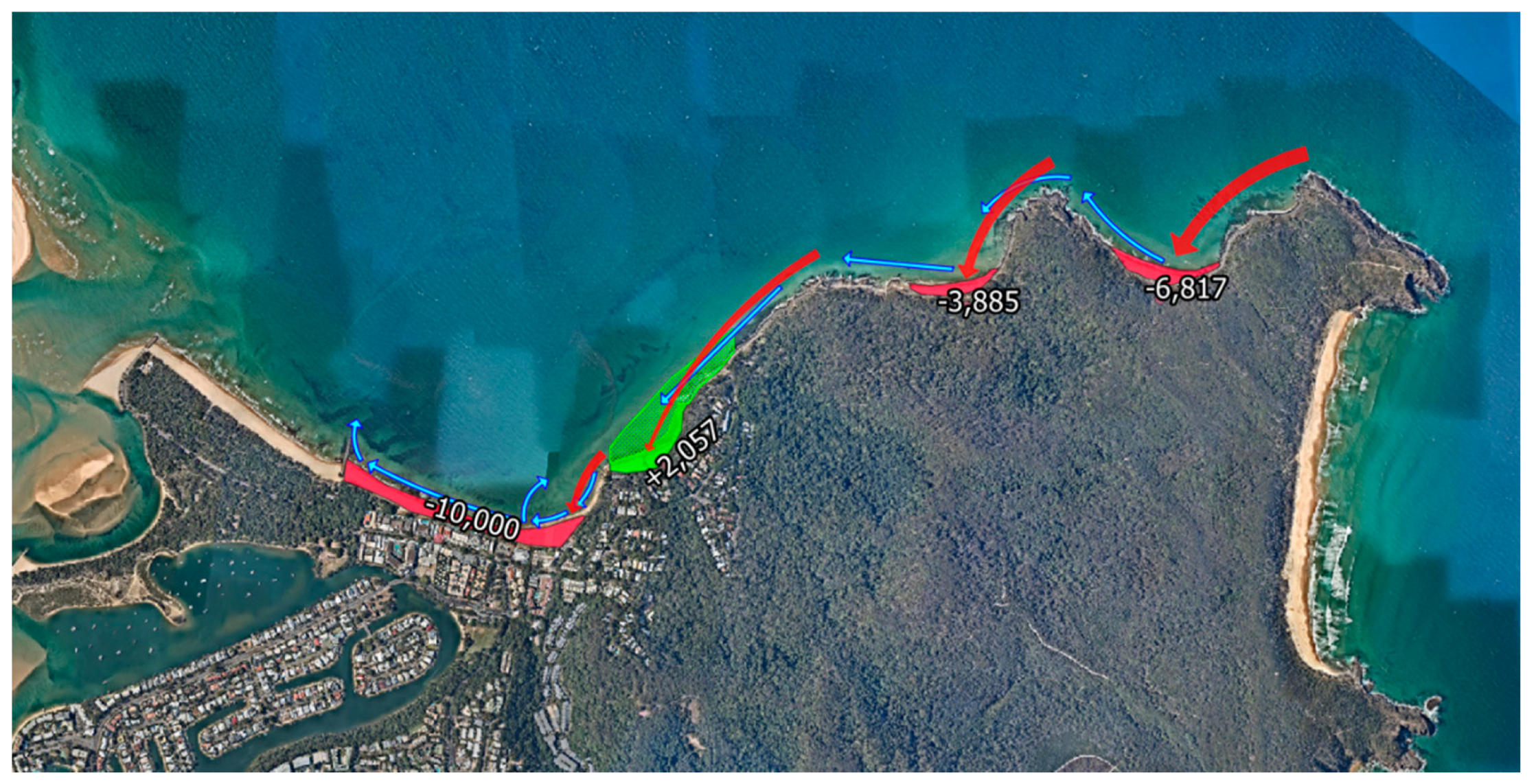
| Parameter | Value |
|---|---|
| Gravity | 9.81 ms−2 |
| Water density | 1025 kgm−3 |
| Boundary wave spectrum | Pierson-Moskowitz |
| Bottom friction (Collins 1972) | 0.015 |
| White capping | Active |
| Diffraction | Inactive |
| Refraction | Active |
| Frequency shift | Active |
| Hs (m) | Tp (s) | Dir (deg) | |
|---|---|---|---|
| MD | 0.02 | 0.62 | −16.48 |
| MAE | 16% | 14% | 42% |
| R2 | 0.80 | 0.04 | 0.11 |
| Beach Compartment | Volume Change (m3) | Width Change (m) |
| Little Cove | +2057 | +7.6 |
| Tea Tree | −3885 | −13.0 |
| Granite Bay | −6817 | −11.5 |
| Noosa Main Beach | −10,000 | −6.2 |
© 2020 by the authors. Licensee MDPI, Basel, Switzerland. This article is an open access article distributed under the terms and conditions of the Creative Commons Attribution (CC BY) license (http://creativecommons.org/licenses/by/4.0/).
Share and Cite
Wishaw, D.; Leon, J.X.; Barnes, M.; Fairweather, H. Tropical Cyclone Impacts on Headland Protected Bay. Geosciences 2020, 10, 190. https://doi.org/10.3390/geosciences10050190
Wishaw D, Leon JX, Barnes M, Fairweather H. Tropical Cyclone Impacts on Headland Protected Bay. Geosciences. 2020; 10(5):190. https://doi.org/10.3390/geosciences10050190
Chicago/Turabian StyleWishaw, Daniel, Javier X. Leon, Matthew Barnes, and Helen Fairweather. 2020. "Tropical Cyclone Impacts on Headland Protected Bay" Geosciences 10, no. 5: 190. https://doi.org/10.3390/geosciences10050190
APA StyleWishaw, D., Leon, J. X., Barnes, M., & Fairweather, H. (2020). Tropical Cyclone Impacts on Headland Protected Bay. Geosciences, 10(5), 190. https://doi.org/10.3390/geosciences10050190






